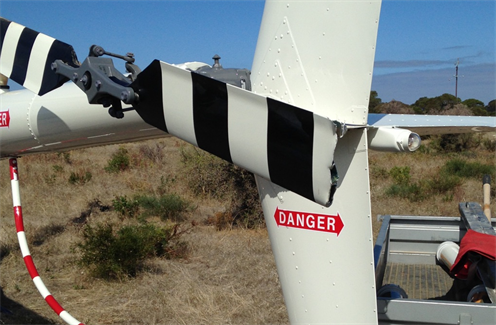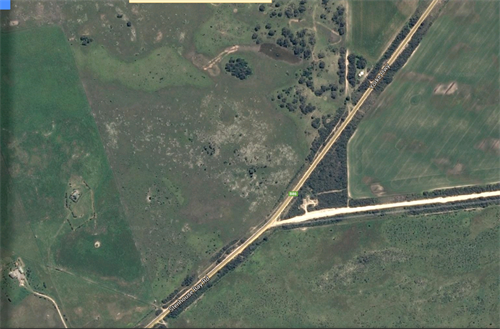What happened
On 10 April 2015, at about 1120 Central Standard Time (CST), the pilot of a Robinson R44 helicopter, registered VH‑LOL (LOL) was engaged in herbicide dispensing operations near Marion Bay on the Yorke Peninsula in South Australia.
Also on board were client representatives who were directing the noxious weed management operation and manually dispensing the chemical into each bush. In the course of traversing the field at low level in search of the weed, the helicopter struck a previously unidentified power line. The helicopter’s main rotor blade made initial contact with the power line and during the avoidance manoeuvre, the tail rotor blades also made contact, severing the blade tips (Figure 1). The pilot landed the helicopter safely. The helicopter was substantially damaged but the occupants were uninjured.
Figure 1: Tail rotor blade damage to VH-LOL

Source: Maintenance organisation
Power line identification
In preparation for the herbicide operations, the pilot conducted an aerial survey of the area. The aerial survey was a standard operating procedure to confirm the powerlines as previously advised by local sources. This survey identified main power lines running parallel to a boundary road and a secondary power line running parallel to the main lines (Figure 2). The secondary line effectively dissected the target area and operations were concentrated on sectors to the north and south of the secondary line. The location of the power lines were also mapped on the data logger that was being used to track the progress of the herbicide dispensing.
The unidentified powerline was a single wire that was strung between the poles supporting the main and secondary powerlines and traversed, unsupported, through the southern boundary of the operational area. It was not mentioned by the locals, nor marked on the data logger map. It was not readily discernible from the air although additional support poles did lead the wire away from the secondary power line towards a distant building.
Figure 2: Powerlines and boundary fencing

Source: Google Earth and modified by ATSB
Pilot comment
The pilot stated that the aerial survey of the powerlines confirmed the accuracy of the local knowledge and created a sense of confidence in him that all obstructions had been identified and accordingly mapped. In hindsight, a fully independent assessment by the pilot in command for the presence of powerlines in the target area may have located the single wire. The pilot had in excess of 14,000 hours operating at low level but not necessarily in powerline congested areas.
Risk management
The helicopter operator had documented a risk assessment of the planned operation, addressing aircraft operational considerations, environmental impacts, required personal protective equipment and herbicide management. The cabin occupants were also provided with a helicopter safety brief and formal induction prior to commencement of flight operations. Risk assessment outcomes and operational requirements were included in a specific job plan that was discussed in briefings with ground and flight crews at the beginning of the campaign. Briefings were also conducted with crews prior to the commencement of each day’s flying.
Wire awareness, detection and avoidance techniques were also documented in the company operations manual in various sections along with specific references to aerial agriculture publications where mitigation for such hazards are addressed.
ATSB comment
This accident provides a reminder to flight crews of the need for consistency in aerial surveys for powerlines, the establishment of standardised procedures for their identification and the need for independent assessment of their presence.
Single wires can be difficult to see and occur in the most unexpected places in rural areas. ATSB research article ‘Avoidable accidents No. 1 - Low level flying’ provides additional information on wire hazards associated with flight below 500’. The report is available at the ATSB website.
‘Avoidable Accidents No. 2 – Wirestrikes involving known wires: A manageable aerial agriculture hazard’ also explains a number of strategies, developed by the Aerial Agriculture Association of Australia (AAAA) and the ATSB, to help pilots manage the on-going risk of wire strikes. The report is available at the ATSB website.
Safety action
Whether or not the ATSB identifies safety issues in the course of an investigation, relevant organisations may proactively initiate safety action in order to reduce their safety risk. The ATSB has been advised of the following proactive safety action in response to this occurrence.
Aircraft operator
As a result of this occurrence, the aircraft operator has advised the ATSB that they are taking the following safety actions:
The operator has reviewed the risk assessment and moved to standardise procedures and now place greater emphasis on employee inductions with a focus on hazards and published information relating to high-risk activities. Whilst the published information was generally available to company pilots, a greater focus on promulgating this information was recognised as beneficial. The use of non-permanent staff was to be reconsidered along with the dissemination and acknowledgement of receipt of safety critical information specific to the contracted flying program.
Operator client
Following a separate, internal investigation into the accident, the client updated its procurement processes. This update was to further ensure that contractor and project sponsor responsibilities were clearly defined in contracts and operational plans, with respect to:
- hazard identification
- operational briefings
- safety inductions.
Aviation Short Investigations Bulletin - Issue 42
Purpose of safety investigationsThe objective of a safety investigation is to enhance transport safety. This is done through:
It is not a function of the ATSB to apportion blame or provide a means for determining liability. At the same time, an investigation report must include factual material of sufficient weight to support the analysis and findings. At all times the ATSB endeavours to balance the use of material that could imply adverse comment with the need to properly explain what happened, and why, in a fair and unbiased manner. The ATSB does not investigate for the purpose of taking administrative, regulatory or criminal action. TerminologyAn explanation of terminology used in ATSB investigation reports is available here. This includes terms such as occurrence, contributing factor, other factor that increased risk, and safety issue. Publishing informationReleased in accordance with section 25 of the Transport Safety Investigation Act 2003 Published by: Australian Transport Safety Bureau © Commonwealth of Australia 2015
Ownership of intellectual property rights in this publication Unless otherwise noted, copyright (and any other intellectual property rights, if any) in this report publication is owned by the Commonwealth of Australia. Creative Commons licence With the exception of the Coat of Arms, ATSB logo, and photos and graphics in which a third party holds copyright, this publication is licensed under a Creative Commons Attribution 3.0 Australia licence. Creative Commons Attribution 3.0 Australia Licence is a standard form licence agreement that allows you to copy, distribute, transmit and adapt this publication provided that you attribute the work. The ATSB’s preference is that you attribute this publication (and any material sourced from it) using the following wording: Source: Australian Transport Safety Bureau Copyright in material obtained from other agencies, private individuals or organisations, belongs to those agencies, individuals or organisations. Where you wish to use their material, you will need to contact them directly. |


